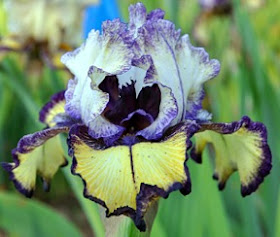By Kathleen Sayce
Written February
17, 2014
I
started growing Pacifica Iris more than fifteen years ago, when the
West Coast was in a warmer, drier weather cycle, so it took several
years for my plants to experience even a little snow. In the past few
years, a few snow days each winter have been more common than not, so
I can now report knowledgeably on what happens to Pacificas in the
snow.
 |
| Iris chrysantha under light snowfall |
First,
some species in my garden, including Iris
hartwegii ssp.
australis, I thompsonii and
I. tenax, normally go
completely dormant. In warmer snow-free years, they may or may not
brown down until February. It's not uncommon for all of these species
to keep green leaves for most of the winter, and then in early March,
suddenly the old battered but still greenish leaves vanish, and a few
weeks later the small, stubby new leaves appear.
Now
add snow to the mix, even just a few days, and wham, the leaves brown
off, and the plants vanish from the surface.
The
second group, of species, includes Iris
innominata, I. chrysophylla and
I. douglasiana, and also hybrids, hangs on and keeps some green leaves all winter long, though those leaves
can look pretty battered, and many are browning off, by late February. Hybrid Pacificas are a mix
of many species, largely from around the Bay Area of the central
California coast and nearby mountains. These tend to have more I.
douglasiana genes,
which is a sturdy evergreen species with large leaves.
 |
| Iris 'Cape Ferrelo' under light snowfall. |
So the hybrids stay evergreen, come
snow, hail, ice storms or torrential rains.
These
traits, evergreen leaves or not, and a tendency to go fully dormant
in snow or not, have helped me sort out the likely genetics of
Pacificas that may come to a gardener without a label, or with an
erroneous one. I.
douglasiana and
I. innomnata have
durable evergreen leaves; I.
douglasiana
leaves tend to be thicker, longer, and wider, while I.
innominata leaves
tend to be a very dark green, narrower, and shorter.
 |
| Seedling Pacifica Iris emerging from snow in the garden. |
My
I. hartwegii
ssp.
australis
plants were grown from seeds collected by a SPCNI member, Richard
Richards, who lives in southern California. The first winter they
experienced snow, I sent Richard a photo to show the plants well
buried in white stuff. He wrote back that there was a drought that
winter in the San Bernardino Mtns, and these plants might be the
happiest individuals of that species anywhere on the West Coast that
year. This was the first year that I noticed just how differently
Pacificas go dormant under snow.
 |
| Iris hartwegii ssp. australis emerging from snow cover. |
The
last photo in this post is a Pacifica iris that was labeled I.
innominata 'Burnt
Sugar' when I bought it many years ago. The leaves are too wide and
long to be solely I.
innominata,
which is the mostly likely species based on flower color. There's not
a hint of dormancy when ice storms and snow arrive. This one has some
I. douglasiana
genes too. By the fairly narrow falls and standards, it is not too
far from a yellow-flowered species selection, and is not a modern
hybrid. ['Burnt Sugar' is not a registered name] Thanks to an
industrious Steller Jay, the original tag, including source, is long
gone.
 |
| Iris 'Burnt Sugar', an unregistered selection, in full flower. |
Knowing now how Pacifica species behave in snow, it's clear that 'Burnt
Sugar' has both I.
douglasiana and
I. innominata
genes, hence the lovely yellow color with red veining on a sturdy
plant with dark green leaves, and no sign of dying back under snow.
To learn more about these irises and others, visit SIGNA, the Species Iris Group of North America's website.









.jpg)






































.jpg)
.1.jpg)
.JPG)
.JPG)